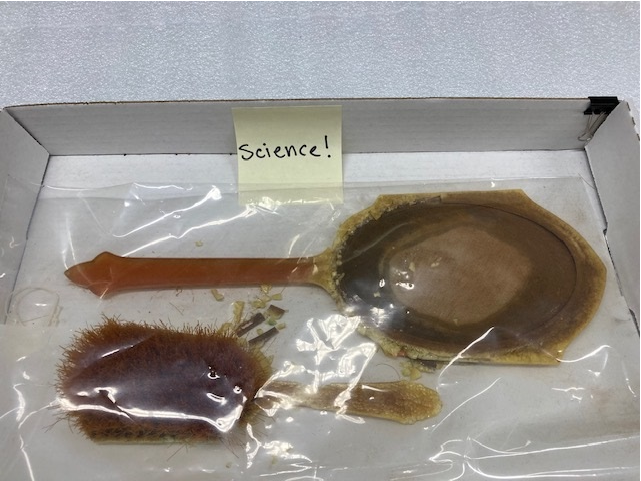Written by Kristin Glomstad-Yoon, Curator of Historic Collections
At this point, we all know the problem with plastic, right? It never goes away. Instead, plastics accumulate and pollute our land and waterways. In landfills, plastics don’t decompose like other materials, but they do break down into smaller and smaller pieces. Eventually these pieces become microplastics, which pollute our world in new ways by gathering in our soil, food sources, and even our own bodies. Once touted as a solution, we now realize that recycling cannot meet the demand or solve the issue entirely. The environmental problem posed by plastic is truly staggering.
Unfortunately, that is not the only plastic problem. While it’s true that plastic never goes away, it’s also true that plastic does not stay in its original form long term. The first fully synthetic plastic, Bakelite, was invented in 1907. Many other types of plastics have been introduced since then, along with additives to add color or strength, or plasticizers for flexibility. While plastics have been around relatively briefly, early plastics are just now beginning to show how they will age – and it’s not good. This presents a significant challenge to museums that collect material culture to document our history and seek to preserve it in perpetuity. While museums are certainly up to the challenge of preserving many unique and priceless artifacts, the industry is discovering that plastics are some of the most fragile items in our collections. Over time, plasticizers and other additives migrate out of the material, leaving behind an object that is often weak, brittle, or shrunken. Unfortunately, once the damage becomes visible it is already too late. Museums have no means of conserving plastic artifacts, and so prevention is currently the only option.

This may not seem like a big deal. With over 22,000 artifacts in the historic collection, the Dubuque County Historical Society is at no loss for material culture to tell the story of the past. But consider how we will tell the story of now in the future. 100 years from now, when our present moment is history, what will museums have in their collections to tell the story of 2023? The answer to that is already in front of you. Look around you at the objects that fill your lives and what you use on a daily basis. Look at mixed media art. Consider our technological and medical innovations. How much of it is made entirely of plastic or includes a plastic component? How much of it was made to last, and how much was designed for a limited use?
Plastic is part of our history. Initially hailed as a promising material that would lessen our dependence on natural resources, the first plastic was developed as an alternative to tortoiseshell and ivory. High demand for these materials had threatened animal populations, and plastic ironically played a role in preventing extinction. However, the use of plastic and its effect on the natural environment has changed drastically since then.
Our dependence on plastics isn’t going away anytime soon, nor is plastic pollution, but our ability to preserve the ordinary and extraordinary moments of human life is changing. As an organization that explores the human connection to the natural environment and inspires stewardship through this connection, the National Mississippi River Museum and Aquarium is responding to both the environmental and preservation conundrums posed by plastic.
